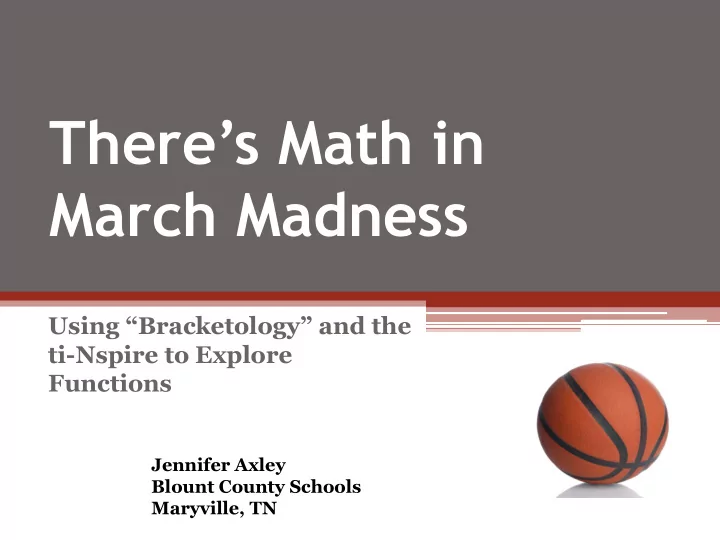

There’s Math in March Madness Using “ Bracketology ” and the ti-Nspire to Explore Functions Jennifer Axley Blount County Schools Maryville, TN
Brief History of NCAA College Basketball Championship Tournament • Founded in 1939 with 8 teams • Expanded to 16 teams in 1951 • Varied between 22 and 25 teams 1953-1974 • Expanded to 32 teams in 1975 • Expanded to 40 teams in 1979 • Expanded to 48 teams in 1980 • There were 52 teams in 1983 and 53 in 1984 • Expanded to 64 teams in 1985 • A play in round expanded the field to 65 teams in 2001 • The current format has 68 teams
March Madness Trivia • H.V. Porter was the first person to use the term “March Madness” to describe a basketball tournament • There are 9.2 quintillion possibilities for possible winners in a 64 team bracket and 147.57 quintillion possibilities in the current 68 team format • UCLA has won the greatest number of NCAA basketball championships with 11 titles. Kentucky is 2 nd with 8 titles. • All four #1 seeds have made it to the final four only one time, in 2008 • There have been three times when none of the #1 seeds made it to the final four, 1980, 2006, and 2011. • Kentucky has won championships under 5 different coaches, Adolph Rupp, Joe B. Hall, Rick Pitino, Tubby Smith, and John Calipari
As Donald Duck once said “You can find math in the darndest places.” This includes various functions that may be modeled through tournament brackets.
Using the ti-Nspire as a tool, we will model some of the functions that can be represented.
1939
1939
2012
2012
1984
1984
Summary: • Math does not just exist in a textbook; it is in life • When we help our students find the “math in life” it becomes real to them • Technology enables students to visualize and conceptually understand math that we did not even study in high school 30 years ago • Not only is “ bracketology ” fun, but there’s actually Math in March Madness !
Sources: • http://en.wikipedia.org/wiki/March_Madness • http://www.allbrackets.com/
There’s Math in March Madness (part 1) March Madness is an informal name for the NCAA Division I Men’s Basketball Tournament, which is a single elimination tournament which is played mostly during the month of March. The tournament began in 1939 with 8 teams. The tournament bracket for 1939 is shown below and includes the results of the games. Complete the following chart to illustrate the number of teams remaining after each tournament round. Rounds Played Teams 0 8 1 1
A. Graph the data from your table on the grid and write an equation for a function that models your data. _________________ B. What type of function did you use (linear, quadratic, exponential, absolute value, square root, etc…). Explain how you determined your function, including the concepts of rate of change and y-intercept. II. The format of the tournament changed in 1951 to include 16 teams. How would this change impact the equation of your function in the previous section? 2
III. The current format for the NCAA Championship tournament includes 68 teams. The completed bracket for the 2012 tournament is shown below. Rounds Played Teams 3
A. Graph the data from your table on the grid and write an equation for a function that models your data. B. If you were to write an equation to model the data in part III , how would it compare and contrast to your equation in I and II ? 4
There’s Math in March Madness (Part 2) I. In Part I we examined the NCAA Championship Tournament Bracket for 2012. The data from that bracket is displayed in the following table. Rounds Played Teams 0 68 1 64 2 32 3 16 4 8 5 4 6 2 7 1 A. Create a scatterplot on your handheld. Can you identify a single function model? If so, which one? If not, why not? 1. Create a function equation that would correspond with the domain from 0 through 1. 2. Create a function equation that would correspond with the domain from 1 through 7. B. When we use two or more functions to describe different parts of the domain, we are using a “piecewise function.” Write the equation for your piecewise function below. C. Let’s go the TI -Nspire handheld and test our equation. 1
II. The following bracket is for the NCAA Tournament Championship in 1984. Represent the data from the bracket in the following table Rounds Played Teams 2
A. Create a scatterplot on your TI-Nspire. How many different pieces will your piecewise function have? B. Create an equation for a piecewise function and write it below. C. Use the plot function tool on your handheld to test your conjecture. Are there any changes that you should make to the equation of your piecewise function? If so, rewrite your equation here. If no changes were necessary, rewrite your equation from B. D. Use words to describe the pieces of your function (it may be linear for certain parts of the domain or exponential for certain parts of the domain). When appropriate, use words such as slope and y-intercept. 3
Recommend
More recommend